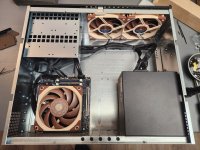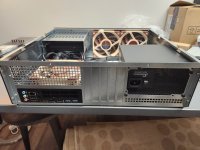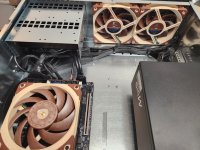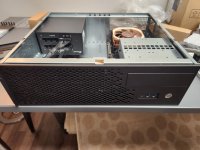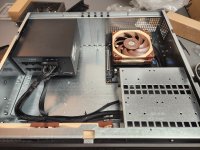A few weeks ago I ordered the MINISFORUM BD790i SE with an AMD Ryzen 9 7940HX CPU when it went on sale for $329 + tax. I also added to this setup:
The MB arrived today and I set it up as Proxmox server to use for a variety of services. Mainly I was interested in seeing what this thing could do for hosting a few VMs and containers for various things I want to play around with. So far I've been very happy with just how easy it was to get everything setup and installed with almost no issues.
I did some load testing on it throughout the day and I found that at idle with Proxmox loaded and no VMs, it is pulling around 22W from my outlet. The CPU temps hover around 34C during this time. When I loaded up a VM with 32 cores and 95GB of memory and ran Prime95 stress testing for 90min or so, I found that the power uses peaked at around 150W and stayed there and thermals topped up to 74C for the rest of the duration.
Later I'll be running some tests on the 2.5Gb ethernet to verify it can run at full speed and then I'll start playing around with other performance and general VM management.
Funny how tiny this little motherboard looks inside my Fractal Design case.
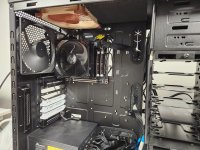
- Crucial RAM 96GB Kit (2x48GB) DDR5 5600MHz
- WD_BLACK 4TB SN850X NVMe
- Noctua NF-A12x25 PWM
- MHQJRH M.2 2280 SSD heatsink, Double-Sided Heat Sink
The MB arrived today and I set it up as Proxmox server to use for a variety of services. Mainly I was interested in seeing what this thing could do for hosting a few VMs and containers for various things I want to play around with. So far I've been very happy with just how easy it was to get everything setup and installed with almost no issues.
I did some load testing on it throughout the day and I found that at idle with Proxmox loaded and no VMs, it is pulling around 22W from my outlet. The CPU temps hover around 34C during this time. When I loaded up a VM with 32 cores and 95GB of memory and ran Prime95 stress testing for 90min or so, I found that the power uses peaked at around 150W and stayed there and thermals topped up to 74C for the rest of the duration.
Later I'll be running some tests on the 2.5Gb ethernet to verify it can run at full speed and then I'll start playing around with other performance and general VM management.
Funny how tiny this little motherboard looks inside my Fractal Design case.


